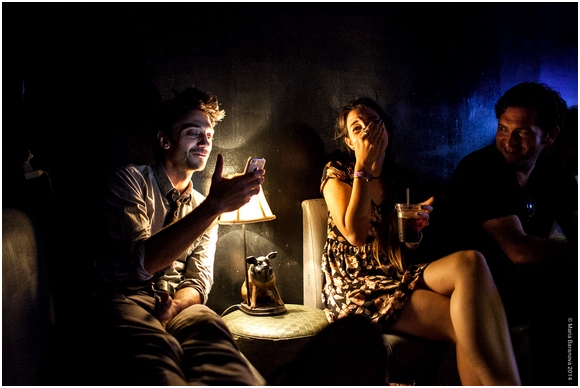Dead Behind These Eyes

Brandt Adams (seated center), Dan Kublick
(standing) and Lori Parquet on mike in
a scene from Dead Behind These Eyes
(Photo credit: Maria Baranova)
“I doubt I could love anyone who did not wish to see Look Back in Anger,” wrote Kenneth Tynan in his landmark 1956 review of the premiere production of John Osborne’s modern classic of youthful despair in grim post WW II England.
Not loving anyone who did not wish to see Dead Behind These Eyes would be more debatable. Performed for an audience of 12 in a karaoke room, the 90-minute show is a beguiling site specific performance art piece. Many theatergoers with an affinity for such works will find it engaging, and others may find it exasperating. Not being familiar with its source material could make it seem even more baffling.
Inspired by and using dialogue from the play, three very talented and highly physical young actors also perform karaoke and interact with the audience, at times quite intensely due to the confined small venue.
After waiting at the fine East Village dive bar Sing Sing Karaoke, where Happy Hour drinks are available for purchase, the audience goes downstairs to sit in a karaoke room. There, an actress chats with them and encourages everyone to make song selections. One doesn’t have to, but it’s likely one will have to at least chat. An actor in a white T-shirt and jeans asks the audience for help with crossword puzzle questions.
Soon, another actor enthusiastically performs a karaoke of Katy Perry’s “Fireworks,” with lively dance moves and then the show really begins. The trio often converse in dialogue from the play, interspersed with their karaoke performances that include Leonard Cohen’s “Hallelujah,” Al Green and Mabon Hodges’ “Take Me To The River,” and Prince’s “Darling Nikki.” That is performed as two of the actors are comically engaged in a simulated sex scene.
There are also video projections of clips from the 1959 film adaptation of Look Back In Anger with Richard Burton, a karaoke film from Bruce Springsteen’s “Born in The U.S.A.” with patriotic imagery, footage of 1960’s U.S.A. social unrest, and of protests in Missouri over the shooting of Michael Brown by police.

Dan Kublick (seated left) in a scene
from Dead Behind These Eyes
(Photo credit: Maria Baranova)
During a short intermission, the audience performs the karaoke songs that they have previously selected. The actors eventually return wearing floppy animal themed pajama costumes. Each particular animal relates to dialogue from the play. At various times during the show, the three actors do a lengthy dance to a rap number, one does a dance on two stools, and two aggressively wrestle each other.
Director Kathryn Hamilton has shaped all of the technical, physical and choreographic elements of the show into a very visually compelling event riddled with aesthetic sequences and tableaus. Dramaturge Jeremy M. Barker weaves John Osborne’s lines with song lyrics into a text that is cryptically provocative. Brian Oh’s video design expertly complements the performances and connects to the themes of the show.
Brandt Adams, Daniel Kublick and Lori Parquet are the three outstanding actors who very effectively channel the characters of Look Back In Anger, including that of the original legendary angry young man, Jimmy Porter. There is a video clip of them in a scene from the play displaying that they would be marvelous in a conventional production of it. They’re all physically commanding and highly personable during their interactions with audience members.
This is a presentation by the theater company Sister Sylvester: “the content of their work is concerned with power: how it is wielded within society at all levels and how language becomes a weapon in enforcing those hierarchies.” Among the company’s inspirations are the 1960s Judson Dance Theater era artists and Reza Abdoh. Their goals include “ensemble-based work that uses multi-disciplinary performance to create stories based in contemporary reality,” “dissonance and difficulty in text, image and sound,” and “exploring/subverting and adapting traditional forms.”
Dead Behind These Eyes definitely achieves all of those concerns in an arresting manner and also succeeds as a perplexing theatrical entertainment.
Dead Behind These Eyes (through September 19th, 2014)
Sister Sylvester
Sing Sing Karaoke, 81 Avenue A, between 5th and 6th Streets, in Manhattan
For tickets, call 212-352-3101 or visit http://www.abronsartscenter.org
Running time: 90 minutes including one intermission

Leave a comment